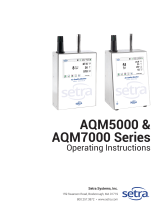
4 EN
particle measuring device BQ30
Information about the device
Device description
The air quality monitor serves to detect the mass concentration
of the particle fractions PM2.5 and PM10 as well as the
CO2concentration and to measure important climate data such
as the relative humidity and temperature of the air.
Nowadays we humans are almost permanently subjected to an
increased particulate matter pollution – be it near heavily
frequented roads, industrial areas or even in living areas. But
over time the concentration of the CO2content also increases
noticeably – particularly in closed or poorly ventilated living
spaces and buildings and with reference to the number of
persons located there.
Ordinary things and tasks such as cooking, vacuuming, candle
or tobacco smoke can be the source of emissions – just like the
emissions from heat sources (e.g. stoves and fireplaces) – and
as such have a direct negative effect on the indoor climate and
consequently the well-being. For an increased concentration of
fine particulates and CO2 in the air can not only affect the overall
well-being, but also be responsible for difficulties in
concentrating and insomnia as well as for various allergic
reactions. On a long-term basis, the exposure to fine
particulates increases the risk of developing cardiovascular and
respiratory diseases, even pulmonary cancer.
Fundamentally, a distinction is made between the two particle
fractions PM10 and PM2.5 for measuring. PM10 includes all
particles with a maximum diameter of 10µm and PM2.5 means
all particles with a diameter of less than 2.5µm These particles
are invisible to the naked eye. As small as they are – especially
the particles of the size PM2.5 – they can reach the pulmonary
alveoli. Yet more minute particles of less than 1µm can even
reach blood vessels.
To detect the data, the particle measuring device sucks in air for
an adjustable amount of time and determines the mass
concentration of the contained particles.
Particles sized 2.5μm and 10.0μm are treated equally during
this process.
The detected values for all active particle sizes are
simultaneously displayed on a colour display. Additionally, the
air contamination is indicated on a colour scale. With respect to
the mass concentration of particle size PM2.5 you can define
limit values preset in the device which, when exceeded, trigger
an acoustic alarm signal. Additionally, a six-level colour display
indicating the respective alarm levels helps you to quickly
assess the current state of the particle concentration ranging
between good and highly critical (see table Alarm limit values
for particle concentration).
The device is equipped with an integrated measuring cell with
laser (class3R laser, 780nm, 1.5-3mW). Owing to the tamper-
proof enclosure it is classified as laser class1 (DINEN60825-1)
according to the Technical Regulations of the Occupational
Health and Safety Ordinance on Artificial Optical Radiation
(TROS) devised by the German Federal Institute for Occupational
Health and Safety. Maintenance and repair work may only be
carried out by trained expert staff observing the legal
regulations.
The device has an automatic baseline calibration function.
Alarm limit values for particle concentration PM2.5
Air quality Value in μg/m3Indicator scale
Good 0 to 35μg/m3Green
Normal 35 to 75μg/m3Yellow
Low contamination 75 to 150μg/m3Orange
Moderate
contamination
150 to 200μg/m3Red
High contamination 200 to 250μg/m3Purple
Severe
contamination
>250μg/m3Dark purple
Alarm limit values for particle concentration PM10
Air quality Value in μg/m3Indicator scale
Good 0 to 75μg/m3Green
Normal 75 to 150μg/m3Yellow
Low contamination 150 to 300μg/m3Orange
Moderate
contamination
300 to 400μg/m3Red
High contamination 400 to 500μg/m3Purple
Severe
contamination
>500μg/m3Dark purple
Alarm limit values for CO2concentration
Air quality CO2value in ppm Indicator colour
measured result1
Good 0 to 800ppm Green
Normal 800 to 1500ppm Orange
Poor 1500 to 9999ppm Red
1In the CO2measuring mode the measured result is indicated in
the respective indicator colour.












